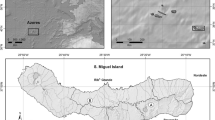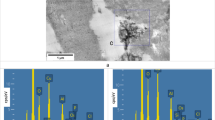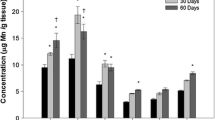Abstract
The autometallographical technique has been used to determine the distribution and cellular localization of mercury deposits in the Wistar rat CNS after exposure to elemental mercury vapor (50–550 μg Hg/m3 of air for 4–24 h). In animals exposed to 50 μg Hg/m3 for 8 h, silver-enhanced mercury grains were confined to the capillary walls. Increasing the concentration of mercury to 500 μg Hg/m3 caused mercury staining to appear in neurons in the corpus striatum, mesencephalic nucleus of the trigeminal nerve and cerebellar deep nuclei. In the spinal cord, mercury appeared primarily in the motoneurons of lamina IX. Following exposure to 550 μg Hg/m3 for 12 h mercury was additionally detected in the ependyma. Animal exposure to 550 μg Hg/m3 for 24 h resulted in visible mercury deposits in the cerebellar and cerebral cortices. In the cerebral cortex, mercury was present in neurons populating lamina III in the isocortex. No mercury was detected in the allocortex. In the cerebellar cortex, mercury staining was limited to the Purkinje cells. Neurons in the thalamus contained heavy accumulations of mercury. Heavy staining for mercury was detected in lung alveolar macrophages in sections prepared from animals exposed to 550 μg Hg/m3 for 24 h. In animals exposed to 500 μg Hg/m3 or more, the primary target cells were the neurons, but glia cells also contained scattered mercury deposits. Ultrastructurally, mercury deposits were detected in the lysosomes.
Similar content being viewed by others
References
Ashe WF, Largent EJ, Dutra FR, Hubbard DM, Blackstone M (1953) Behavior of mercury in the animal organism following inhalation. AMA Arch Indust Hyg Occup Med 7: 19–43
Baatrup E, Frederickson CJ (1989) Darkfield illumination improves microscopic detection of metals in Timm stained tissue. Histochem J 21: 477–480
Berlin M (1986) Mercury. In: Friberg L, Nordberg GF, Vouk VB (eds) Handbook on the toxicology of metals, 2nd edn, vol II. Elsevier. Amsterdam New York Oxford, pp 387–445
Berlin M, Jerksell LG, Ubisch H (1966) Uptake and retention of mercury in the mouse brain. Arch Environ Health 12: 33–42
Berlin M, Fazackerley J, Nordberg G (1969) The uptake of mercury in the brains of mammals exposed to mercury vapour and to mercuric salts. Arch Environ Health 18: 719–729
Cassano GB, Amaducci L, Viola PL (1966) Distribution of mercury (Hg203) in the brain of chronically intoxicated mice (autoradiographic study). Riv Patol Nerv Ment 87: 214–225
Cassano GB, Viola PL, Ghetti B, Amaducci L (1969) The distribution of inhaled mercury (Hg203) vapors in the brain of rats and mice. J Neuropathol Exp Neurol 29: 308–320
Clarkson TW, Gatzy J, Dalton C (1961) Studies of the equilibrations of mercury vapour with blood. University of Rochester AEP Report No 582
Danscher G, Møller-Madsen B (1985) Silver amplification of mercury sulfide and selenide: a histochemical method for light and electron microscopic localization of mercury in tissue. J. Histochem Cytochem 33[3]: 219–228
Danscher G, Rungby J (1986) Differentiation of histochemically visualized mercury and silver. Histochem J 18: 109–114
Evans MJ, Cabral LJ, Stephens RJ, Freeman G (1973) Cell division of alveolar macrophages in rat lung following exposure to NO2. Am J Pathol 70: 199–208
Halbach S, Clarkson TW (1978) Enzymatic oxidation of mercury vapour by erythrocytes. Biochim Biophys Acta 523: 522–531
Hayes AD, Rothstein A (1962) The metabolism of inhaled mercury vapour in the rat studied by isotope techniques. J Pharmacol Exp Ther 138: 1–10
Magos L (1967) Mercury blood interactions and mercury uptake by brain. Environ Res 1: 323–337
Magos L (1968) Uptake of mercury by brain. Br J Ind Med 25: 315–318
Magos L (1971) Selective atomic absorption determination of inorganic mercury and methyl mercury in undigested biological samples. Analyst 96: 847–853
Magos L, Clarkson TW (1972) Atomic absorption determination of total inorganic and organic mercury in blood. J Assoc Off Anal Chem 55: 966–971
Magos L, Halbach S, Clarkson TW (1978) Role of catalase in the oxidation of mercury vapour. Biochem Pharmacol 27: 1373–1377
Møller-Madsen B, Danscher G (1986) Localization of mercury in CNS of the rat. I. Mercuric chloride (HgCl2) per os. Environ Res 41: 29–43
Møller-Madsen B (1990) Localization of mercury in CNS of the rat. II. Intraperitoneal injection of methylmercuric chloride (CH3HgCl) and mercuric chloride (HgCl2). Toxicol Appl Pharmacol 103[2]: 303–323
Møller-Madsen B (1991) Localization of mercury in CNS of the rat. III. Methylmercuric chloride (CH3HgCl) per os. Fundam Appl Toxicol 16: 172–187
Møller-Madsen B, Danscher G (1991) Localization of mercury in CNS of the rat. IV. Oral administration of CH3HgCl or HgCl2 with or without Na2SeO3. Toxicol Appl Pharmacol 108: 457–473
Nielsen-Kudsk F (1965) Absorption of mercury vapour from the respiratory tract in man. Acta Pharmacol Toxicol 23: 250–262
Nielsen-Kudsk F (1969) Uptake of mercury vapour in blood in vivo and in vitro from mercury-containing air. Acta Pharmacol Toxicol 27: 149–160
Nordberg GF, Serenius F (1969) Distribution of inorganic mercury in the guinea pig brain. Acta Pharmacol Toxicol 27: 269–283
Nørgaard JOR, Møller-Madsen B, Hertel N, Danscher G (1989) Silver enhancement of tissue mercury: demonstration of mercury in autometallographic silver grains from rat kidneys. J Histochem Cytochem 37[10]: 1545–1547
Paxinos G, Watson C (1986) The rat brain in stereotaxic coordinates. Academic Press, New York
Peters A, Palay SL, Webster H de F (1976) The fine structure of the nervous system: the neurons and supporting cells, WB Saunders, Philadelphia London Toronto
Reynolds ES (1963) The use of lead citrate at high pH as an electronopaque stain in electron microscopy. J Cell Biol 17: 208–212
Watson ML (1958) Staining of tissue sections for electron microscopy with heavy metals. J Biophys Biochem Cytol 4[4]: 475–478
Whittaker SG, Smith DG, Foster JR, Rowland IR (1990) Cytochemical localization of mercury inSaccharomyces cerevisiae treated with mercuric chloride. J Histochem Cytochem 38[6]: 823–827
Author information
Authors and Affiliations
Rights and permissions
About this article
Cite this article
Møller-Madsen, B. Localization of mercury in CNS of the rat. Arch Toxicol 66, 79–89 (1992). https://doi.org/10.1007/BF02342499
Received:
Accepted:
Issue Date:
DOI: https://doi.org/10.1007/BF02342499




